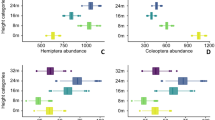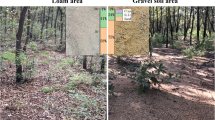Abstract
Insect guild abundance and species richness responses to numerically dominant ant species, seasonality, and canopy structure were analysed in a successional montane tropical rainforest. Samples were taken in wet and dry seasons at three sites that had been subject to different past land use (low, intermediate, and high disturbance) and have been protected since 1967. We took two habitat scales (isolated tree crowns and canopy segments) and three categories for numerically dominant ants (presence of only one, or more than one species, or absence of dominant ant). Our results show that the larger the crown is, the bigger the chance to find herbivores is. Total insect species abundance, sap-sucking species richness, and prey abundance were higher in the low disturbance site, where the largest crowns were found, but simpler canopies showed the greatest frequency of dominant ants, and the lowest abundance of chewing insects. Sap-sucking species were more abundant in the low disturbance site, but mostly on crowns with dominant ant species. Dominant ant abundance was higher, and leaf-chewer species abundance was lower, in the high disturbance site. At the canopy scale, sap-sucking and prey species abundance and richness were higher in the low disturbance site, where canopy heterogeneity was the greatest, whereas leaf-chewers did not respond to disturbance at all. Sap-sucking species abundance was higher in areas with a simple ant species dominance. This is the first work to show how canopy insects are concomitantly affected by numerically dominant ants and canopy structure in this Atlantic rainforest ecosystem.





Similar content being viewed by others
References
Alves-Silva E (2011) Post fire resprouting of Banisteriopsis malifolia (Malpighiaceae) and the role of extrafloral nectaries on the associated ant fauna in a Brazilian savanna. Sociobiology 58:327–339
Basset Y, Cizek L, Cuénoud P et al (2012) Arthropod diversity in a tropical forest. Science 338:1481–1484
Blüthgen N, Stork NE (2007) Ant mosaics in a tropical rainforest in Australia and elsewhere: a critical review. Austral Ecol 32:93–104
Blüthgen N, Verhaagh M, Goitía W, Jaffé K, Morawetz W, Barthlott W (2000) How plants shape the ant community in the Amazonian rainforest canopy: the key role of extrafloral nectarines and homopteran honeydew. Oecologia 125:229–240
Blüthgen N, Stork NE, Fiedler K (2004) Bottom-up control and co-occurrence in complex communities: honeydew and nectar determine a rainforest ant mosaic. Oikos 106:344–358
Bolton B (1994) Identification guide to the ant genera of the world. Harvard University Press, Cambridge
Borror DJ, Triplehorn CA, Johnson NF (2002) An introduction to the study of insects. Saunders College, Philadelphia
Bronstein JL, Armbruster WS, Thompson JN (2014) Understanding evolution and complexity of species interactions using orchids as a model system. New Phytol 202:373–375
Brown KS Jr (1991) Conservation of Neotropical environments: insects as indicators. In: Collins NM, Thomas JA (eds) The conservation of insects and their habitats. Royal Entomological Society Symposium XV. Academic Press, London, pp 349–404
Campos RI, Vasconcelos HL, Ribeiro SP, Neves FS, Soares JP (2006) Relationship between tree size and insect assemblages associated with Anadenanthera macrocarpa. Ecography 29:442–450
Casas J, Djemai I (2002) Plant canopy architecture and multitrophic interactions. In: Tscharnke T, Hawkins B (eds) multitrophic interactions. Cambridge University Press, Cambridge, pp 174–196
Costa CB, Ribeiro SP, Castro PTA (2010) Ants as bioindicators of natural succession in savanna and riparian vegetation impacted by dredging in the Jequitinhonha river basin, Brazil. Restor Ecol 18(Suppl.):148–157
Davidson DW, Cook SC, Snelling RR, Chua TH (2003) Explaining the abundance of ants in lowland tropical rainforest canopies. Science 300:969–972
Dejean A, Corbara B, Orivel J, Leponce M (2007) Rainforest canopy ants: the implications of territoriality and predatory behavior. Funct Ecosyst Commun 1:105–120
Delabie JHC (2001) Trophobiosis between Formicidae and Hemiptera (Sternorrhyncha and Auchenorrhyncha): an overview. Neotrop Entomol 30:501–516
DeVries PJ (1987) The butterflies of Costa Rica and their natural history: Papilionidae, Pieridae, Nymphalidae. Princeton University Press, Princeton
Dorneles LPP, Waechter JL (2004) Fitossociologia do componente arbóreo na floresta turfosa do Parque Nacional da Lagoa do Peixe, Rio Grande do Sul, Brasil. Acta Bot Bras 18:815–824
Espírito-Santo NB, Ribeiro SP, Lopes JFS (2012) Evidence of competition between two canopy ant species: is aggressive behavior innate or shaped by a competitive environment? Psyche (Camb Mass) 2012. doi:10.1155/2012/609106
Fagundes R, Del-Claro K, Ribeiro SP (2012) Effects of the trophobiont herbivore Calloconophora pugionata (Hemiptera) on ant fauna associated with Myrcia obovata (Myrtaceae) in a montane tropical forest. Psyche (Camb Mass) 2012. doi:10.1155/2012/783945
Fagundes R, Ribeiro SP, Del-Claro K (2013) Tending-ants increase survivorship and reproductive success of Calloconophora pugionata Drietch (Hemiptera, Membracidae), a trophobiont herbivore of Myrcia obovata O. Berg (Myrtales, Myrtaceae). Sociobiology 60:11–19
Fernandéz F (2003) Introducción a las hormigas de la región Neotropical. Instituto de investigación de recursos biológicos Alexander von Humboldt, Bogotá
Freitas AVL (2010) Impactos potenciais das mudanças propostas no Código Florestal Brasileiro sobre as borboletas. Biota Neotrop 10:53–57
Freitas AVL, Oliveira PS (1996) Ant as selective agents on herbivore biology: effects on the behaviour of a non-myrmecophilous butterfly. J Anim Ecol 65:205–210
Fujaco MAG, Leite MGP, Messias MCTB (2010) Análise multitemporal das mudanças no uso e ocupação do Parque Estadual do Itacolomi (MG) através de técnicas de geoprocessamento. R Esc Minas 63:695–701
Gonçalves TT, Reis R Jr, DeSouza O, Ribeiro SP (2005) Predation and interference competition between ants (Hymenoptera: Formicidae) and arboreal termites (Isoptera: Termitidae). Sociobiology 46:409–419
Heads PA, Lawton JH (1985) Bracken, ants and extrafloral nectaries. III. How insect herbivores avoid predation. Ecol Entomol 10:29–42
Lescano MN, Farji-Brener AG, Gianoli E (2014) Nocturnal resource defence in aphid-tending ants of northern Patagonia. Ecol Entomol 39:203–209
Longino JT, Nadkarni NM (1990) A comparison of ground and canopy leaf litter ants (Hymenoptera: Formicidae) in a neotropical montane forest. Psyche (Camb Mass) 97:81–93
Lowman MD (1985) Temporal and spatial variability in insect grazing of the canopies of five Australian rainforest tree species. Aust J Ecol 10:7–24
Lowman MD (1995) Herbivory as a canopy process in rain forest trees. In: Lowman MD, Nadkarni NM (eds) Forest canopies. Academic Press, Burlington, pp 431–455
Majer JD, Delabie JHC, Smith MRB (1994) Arboreal ant community patterns in Brazilian cocoa farms. Biotropica 26:73–83
Marinoni RC, Ganho NG, Monné ML, Mermudes JRM (2006) Hábitos alimentares em Coleoptera (Insecta). Holos Editora, Curitiba
Minitab Statistical Software (2013) MINITAB Statistical Software 16. http://www.minitab.com/pt-BR/default.aspx?langType=1046. Accessed 23 May 2014
Mody K, Linsenmair KE (2004) Plant-attracted ants affect arthropod community structure but not necessarily herbivory. Ecol Entomol 29:217–225
Neves FS, Araújo LS, Espírito-Santo MM, Fagundes M, Fernandes GW, Sanchez-Azofeifa GA, Quesada M (2010) Canopy herbivory and insect herbivore diversity in a dry forest–savanna transition in Brazil. Biotropica 42:112–118
Neves FS, Sperber CF, Campos RI, Soares JP, Ribeiro SP (2013) Contrasting effects of sampling scale on insect herbivores distribution in response to canopy structure. Rev Biol Trop 61:125–137
Novotny V, Basset Y, Miller SE, Weiblen GD, Bremer B, Cizek L, Drozd P (2002) Low host specificity of herbivorous insects in a tropical forest. Nature 416:841–844
Nunes RFY, Fagundes M, Santos RM, Dominguez EBS, Almeida HS, Gonzaga APD (2005) Atividades fenológicas de Guazuma ulmifolia Lam. (Malvaceae) em uma floresta estacional decidual no norte de Minas Gerais. Lundiana 6:99–105
Oliveira PS, Del-Claro K (2005) Multitrophic interactions in a neotropical savanna: ant-hemipteran systems, associated insect herbivores and a host plant. In: Burslem DFRP, Pinard MA, Hartley SE (eds) Biotic interactions in the tropics: their role in the maintenance of species diversity. Cambridge University Press, Cambridge, pp 414–438
Oliveira PS, Sendoya SF, Del-Claro K (2012) Defesas bióticas contra herbívoros em plantas de cerrado: interações entre formigas, nectários extraflorais e insetos trofobiontes. In: Del-Claro K, Torezan-Silingardi HM (eds) Ecologia das interações plantas-animais: uma abordagem ecológico-evolutiva. Technical Books, Rio de Janeiro, pp 155–165
Oliveira-Filho AT, Fontes MAL (2000) Patterns of floristic differentiation among Atlantic forests in southeastern Brazil and the influence of climate. Biotropica 32:793–810
Ozanne CMP, Anhuf D, Boulter SL et al (2003) Biodiversity meets the atmosphere: a global view of forest canopies. Science 301:183–187
Queiroz ACM, Costa FV, Neves FS, Fagundes M (2013) Does leaf ontogeny lead to changes in defensive strategies against insect herbivores? Arthropod Plant Interact 7:99–107
R Development core team (2012) R: a language and environment for statistical computing. R Foundation for Statistical Computing, Vienna. http://www.R-project.org
Rafael JA, Melo GAR, Carvalho JB, Casari SA, Constantino R (2012) Insetos do Brasil: diversidade e taxonomia. Holos Editora, Ribeirão Preto
Ribas CR, Campos RBF, Schmidt FA, Solar RRC (2012) Ants as indicators in Brazil: a review with suggestions to improve the use of ants in environmental monitoring programs. Psyche (Camb Mass) 2012. doi:10.1155/2012/636749
Ribeiro SP, Basset Y (2007) Gall-forming and free-feeding herbivory along vertical gradients in a lowland tropical rainforest: the importance of leaf sclerophylly. Ecography 30:663–672
Ribeiro SP, Borges PAV (2010) Canopy habitat area effect on the arthropod species densities in the Azores: pondering the contribution of tourist species and other life histories. In: Serrano ARM, Borges PAV, Boieiro M, Oromí P (eds) Terrestrial arthropods of Macaronesia: biodiversity, ecology and evolution. Sociedade Portuguesa de Entomologia, Lisboa, pp 81–106
Ribeiro SP, Borges PAV, Gaspar C, Melo C, Serrano ARM, Amaral J, Aguiar C, André G, Quartau JA (2005) Canopy insect herbivores in the Azorean Laurisilva forests: key host plant species in a highly generalist insect community. Ecography 28:315–330
Ribeiro SP, Soares JP, Campos RI, Martins RP (2008) Insect herbivores species associated to pioneer tree species: contrasting within forest and ecotone canopy habitats. Rev Bras Biol 10:237–248
Ribeiro SP, Espírito-Santo NB, Delabie JHC, Majer JD (2013) Competition, resources and the ant (Hymenoptera: Formicidae) mosaic: a comparison of upper and lower canopy. Myrmecol News 18:113–120
Room PM (1971) The relative distribution of ant species in Ghana’s cocoa farms. J Anim Ecol 40:735–751
Schoereder JH, Sobrinho TG, Madureira MS, Ribas CR, Oliveira PS (2010) The arboreal ant community visiting extrafloral nectarines in the neotropical cerrado savanna. Terr Arthropod Rev 3:3–27
SPSS Software 13.0. Statistical package for the social sciences. http://en.softonic.com/s/spss-13.0-free-software-download. Accessed 23 May 2014
Stiling P, Moon DC (2005) Quality or quantity: the direct and indirect effects of host plants on herbivores and their natural enemies. Oecologia 142:413–420
Styrsky JD, Eubanks MD (2007) Ecological consequences of interactions between ants and honeydew-producing insects. Proc Biol Sci 274:151–164
Thompson JN (2014) Natural selection, coevolution, and the web of life. Am Nat 183:iv–v
Triplehorn CA, Johnson NF (2011) Estudos dos insetos. Cengage Learning, São Paulo
Uehara-Prado M, Freitas AVL (2009) The effect of rainforest fragmentation on species diversity and mimicry ring composition of ithomiine butterflies. Insect Conserv Div 2:23–28
Vilela AA, Torezan-Silingardi HM, Del-Claro K (2014) Conditional outcomes in ant–plant–herbivore interactions influenced by sequential flowering. Flora 209:359–366
Acknowledgments
The authors are indebted to Instituto Estadual de Florestas for the field support and Dr. Rodrigo Feitosa (Universidade Federal do Paraná), who helped us with ant identification. R.B.F. Campos and G.M. Lourenço are supported by a CAPES (Coordenação de Aperfeiçoamento de Pessoal de Nível Superior) Grant and S.P. Ribeiro by a CNPq (Conselho Nacional de Desenvolvimento Científico e Tecnológico) Grant. The work also received financial support from FAPEMIG (Fundação e Amparo à Pesquisa de Minas Gerais) and PROPP/UFOP (Pro-reitoria de pesquisa e pós-graduação/Universidade Federal de Ouro Preto).
Author information
Authors and Affiliations
Corresponding author
Additional information
Handling Editor: Stanislav Gorb.
Rights and permissions
About this article
Cite this article
Lourenço, G.M., Campos, R.B.F. & Ribeiro, S.P. Spatial distribution of insect guilds in a tropical montane rainforest: effects of canopy structure and numerically dominant ants. Arthropod-Plant Interactions 9, 163–174 (2015). https://doi.org/10.1007/s11829-015-9359-y
Received:
Accepted:
Published:
Issue Date:
DOI: https://doi.org/10.1007/s11829-015-9359-y




